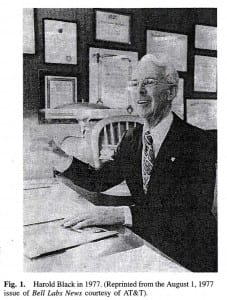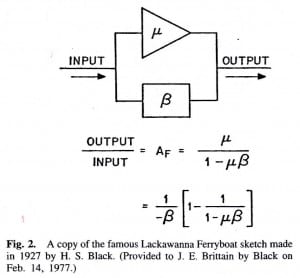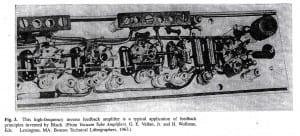Scanning the Past: A History of Electrical Engineering from the Past
Submitted by Marc Bell, Editor
Copyright 1997 IEEE. Reprinted with permission from the IEEE publication, “Scanning the Past” which covers a reprint of an article appearing in the Proceedings of the IEEE Vol. 85, No. 8, August 1997.
Harold S. Black and the Negative Feedback Amplifier
Seventy years ago this month, H. S. Black (Fig. 1) of Bell Telephone Laboratories conceived the negative feedback amplifier while aboard the Lackawanna Ferry on his way to work. Thirty years later,  M. J. Kelly, president of the Bell Labs, characterized Black’s invention as ranking with the de Forest audion “as one of the two inventions of broadest scope and significance in electronics and communications of the past 50 years.” Kelly credited the negative feedback amplifier with having made possible the long-distance telecommunications networks that covered the country, as well as transoceanic telephone cables. He noted that by 1957, the application of the negative feedback principle had transcended telecommunications and had stimulated “the entire explosive extension of the area of control, both electrical and mechanical.”
M. J. Kelly, president of the Bell Labs, characterized Black’s invention as ranking with the de Forest audion “as one of the two inventions of broadest scope and significance in electronics and communications of the past 50 years.” Kelly credited the negative feedback amplifier with having made possible the long-distance telecommunications networks that covered the country, as well as transoceanic telephone cables. He noted that by 1957, the application of the negative feedback principle had transcended telecommunications and had stimulated “the entire explosive extension of the area of control, both electrical and mechanical.”
Black was born in Leominister, MA, in 1898 and graduated in electrical engineering from the Worcester Polytechnic Institute in 1921. That year, he joined the Systems Engineering Department of the Western Electric Company in New York City, which became part of Bell Laboratories in 1925. He frequently came to the office on Sundays to peruse technical reports on projects covering the past two decades. His initial assignment was to investigate distortion in vacuum-tube amplifiers used as repeaters in telephonic carrier systems. He undertook a laborious analysis of distortion and linearity requirements as a function of the number of channels and designed various amplifiers in a quest for circuits suitable for multichannel amplifiers used in tandem over long distances. During the 1920’s, he worked closely with Kelly, who was in charge of vacuum-tube research.
In March 1923, Black attended an inspiring talk by C. P. Steinmetz, which, according to Black, provided a stimulus to his invention of a “feedforward amplifier.” This invention, which he patented in 1928, utilized biconjugate networks to isolate and cancel distortion. The technique proved fairly successful in laboratory tests but required frequent adjustment of the filament current and plate voltage and was too complicated to use commercially. Thus, it was in the context of a research effort extending over a number of years that Black came up with the negative feedback concept in early August 1927. He sketched out a preliminary design, including feedback equations, on a blank page of The New York Times and had it witnessed
and signed when he arrived at work (Fig. 2). By December 1927, he demonstrated a large reduction in distortion in an actual amplifier using negative feedback. Field tests were carried out in the vicinity of Morristown, NJ, during 1930-1931 using a nine-channel system with about 70 repeaters. These experiments proved highly successful and convinced even more skeptical engineers that the negative feedback amplifier was the long-sought solution to the problem of distortion in long-distance telephone networks where numerous repeaters were-needed.
Black’s classic paper entitled “Stabilized Feed-Back Amplifiers” appeared in Electrical Engineering, a publication of the American Institute of Electrical Engineers (AJEE), in January 1934. He pointed out in this paper that the use of negative feedback in a high-gain amplifier enabled “extraordinary improvement in Constance of amplification and freedom from nonlinearity.” He reported the Morristown tests and stated that results had been “highly satisfactory and demonstrated conclusively the correctness of the theory and the practicability of its commercial application.” He cited a related contribution made by his colleague H. Nyquist, who had developed a precise criterion for the stability of feedback amplifiers. Black concluded that vacuum-tube amplifiers “normally possessing good characteristics with respect to stability and freedom from distortion are made to possess superlatively good characteristics by application of the feed-back principle.” Black’s patent on the negative feedback amplifier featured broad claims and included 42 pages of text, 33 pages of figures, and nine pages of claims. Although he applied for the patent in August 1928, it was not issued until December 1937. It was required reading in at least one graduate course in electronics offered in the late 1950’s. During World War II, Black made important contributions to the theory and applications of pulse-code modulation. His book Modulation Theory was published in 1953. He was elected a fellow of the ATEE in 1941 and was awarded the Lamme Medal by the AIEE in 1957 as recognition for the invention of the negative feedback amplifier and other contributions to telecommunications engineering (Fig. 3). He also was elected a fellow of the Institute of Radio Engineers in 1948. He retired from Bell Labs in 1963 and then worked for about three years as a research scientist with the General Precision Company. In later years, he was an independent communications consultant. He was inducted into the National Inventors Hall of Fame in 1981. He did some preliminary work on an autobiography with the tentative title Before the Ferry Docked but it remained unfinished when he died in December 1983 at age 85.
During World War II, Black made important contributions to the theory and applications of pulse-code modulation. His book Modulation Theory was published in 1953. He was elected a fellow of the ATEE in 1941 and was awarded the Lamme Medal by the AIEE in 1957 as recognition for the invention of the negative feedback amplifier and other contributions to telecommunications engineering (Fig. 3). He also was elected a fellow of the Institute of Radio Engineers in 1948. He retired from Bell Labs in 1963 and then worked for about three years as a research scientist with the General Precision Company. In later years, he was an independent communications consultant. He was inducted into the National Inventors Hall of Fame in 1981. He did some preliminary work on an autobiography with the tentative title Before the Ferry Docked but it remained unfinished when he died in December 1983 at age 85.
James E. Brittain
